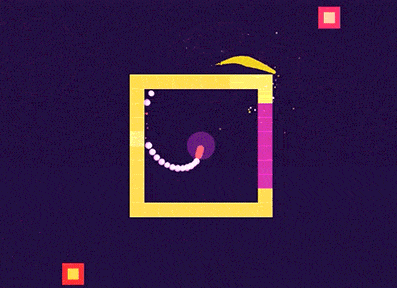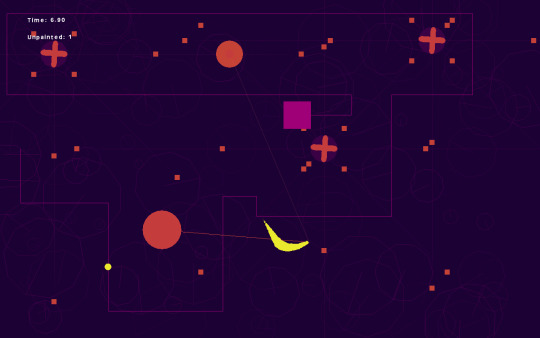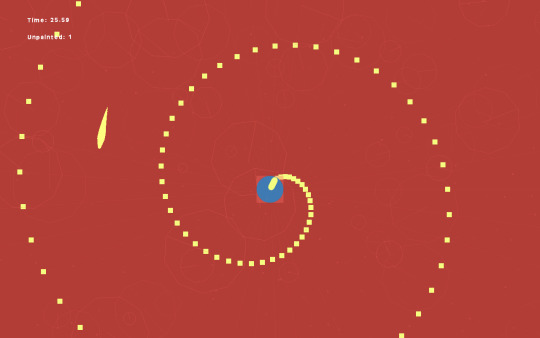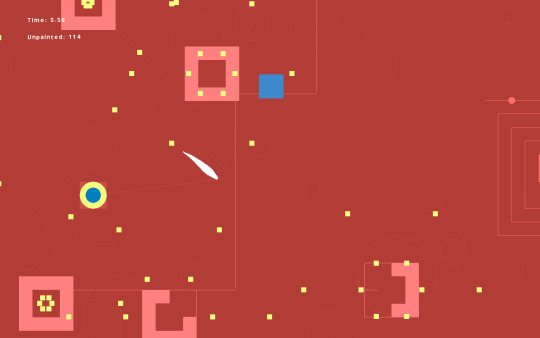Video
youtube
A new teaser trailer
#soft body game#soft body#zeke virant#indie games#ps4#psvita#twin-stick#bullet hell#shmup#abstract#NYU Game Center
1 note
·
View note
Text
Two Questions
1) Please tell us a little about your game, Soft Body. Did you make the game yourself? How long did it take you to think of the idea and program it?
Soft Body is, at its heart, an action game that is similar to popular, old arcade games like Pac-Man or Galaga, but I have tried to infuse contemplative and ethereal elements into the game such as odd control schemes and meditative music and sound. Before developing video games, I composed music and words for operas. I always want to be fully involved in every aspect of development, and so I am designing Soft Body by myself. That's not entirely true, though. I am lucky to receive feedback and criticism from fellow game developers and players. It's important not to work in a bubble.
As of now, I've spent almost 1 year programming and designing the game. That being said, the concept and idea of the game was not preconceived. I usually try to keep some distance from a project before fully committing to it. It's nice and encouraging to stumble upon the good ideas because the opposite, over-thinking and over-preparing, can be very disappointing and kill creativity. In the beginning, I knew I wanted to make a game that felt good to control, but in reality, that idea was too open-ended. It wasn't until I put sound effects into the game that it took any shape.
2) What is unique about Soft Body, and how does it compare to big company games? What did you want to express through this game?
In Soft Body, players can control two characters at the same time. This challenging mechanic provides the unique experience of learning how to split one's mind. I find it similar to singing and playing guitar at the same time, and most players find this a fun and fascinating experience. This learning curve in combination with the music, sound design, and the visual appearance of the players' avatars helps to create a synesthetic experience.
The divide between small games and big games on a design level isn't clear to me--at least on a basis of labor and skills. On some level, small developers and big developers are doing the same jobs. Plenty of big developers have made fantastic, innovative contributions to games. For example, a game like Guitar Hero was a fascinating and original game. But I guess the problem is always growth. Large developers need to make more money or they lay people off. Thus, Harmonix makes a lot of Guitar Hero and Guitar Hero-like sequels. They can take gambles here and there, but not too many big developers have the luxury of making the games they want to make; they make the games they have to make. Of course this is an over-simplification. I admit that I am in many ways ignorant of the situation, but I did not want to simply back down from the question.
As a smaller developer, I am allowed a greater degree of freedom throughout development. If I choose to experiment, and I make a blunder or a bad decision, it's not that big of a deal. I probably learned something and that experience is usually immediately applicable to my game in some degree. I don't have to worry about wasting the time of hundred people.
Soft Body doesn't have a narrative or an underlying message. Rather than express larger concepts like failure or love, Soft Body is more akin to playing a musical instrument. It allows one the option of finding beauty or challenge or whatever they're looking for on their own terms.
0 notes
Text
Soft Body's Level Design

Soft Body's level design has been a great challenge. Here is the basic concept for anyone who doesn’t understand the game: paint all the walls by getting close to it with the Soft Body. When all of the walls are painted, they will disappear and a new layer of unpainted walls will appear. After all the layers have been painted, the level is complete. Some levels have only 1 or 2 layers, and others have up to 12.
While the design is simple, it was the result of many months of iterating and adding to the game's core mechanics and rules: adding objectives, deciding on the abilities of the Soft Body and Ghost Body, color coding objects so that goals were discernible, and so on. But even with more stuff and tighter mechanics, I felt there was something missing with the game. I had gotten to the point where I would work on a level for around 20 minutes and wouldn't have any ideas on how to improve the level design. Large levels weren’t too different than small levels, and harder levels were pretty much the same designs as easier levels except with more enemies. In short, there wasn't much design in the game's level designs.
With a layered, reactive approach to level design, I am able to solve so many problems. It feels like an enormous game design victory: 1) levels can be longer without being cluttered or too big 2) it gives longer levels clear objectives and small victories 3) it is easier to carefully tune the difficulty throughout a level 4) levels are capable of more expressive, personal touches like surprises (e.g., trapping the player in a small walled-in space). In the past, I have talked a lot about how the feel and flow of the game, specifically the player movement, has been the main focus of the game’s design. But as those things begin to feel more complete, I’m finding that being able to step away from that space is central to designing a good level. Even if a level’s design starts off terrible and confusing, the new levels are more malleable, and it’s easier to surprise myself.
1 note
·
View note
Text
Bullet Patterns
Dodging and movement is the most important aspect of my game. Winding around projectiles and predicting the enemy AI is rewarding. Allowing people to learn several systems and interact with them simultaneously and spontaneously is one of the best parts of any bullet hell game.
In order to support this, it's important to make discernible, consistent bullet patterns and readable enemy actions. A good bullet pattern will not surprise people. It may not even be hard to avoid. Difficulty is not important, readability is. A good pattern will force people to make decisions and take actions. If they can't find a pattern, they will not react, they will collide with an seemingly random projectile, and they will feel cheated.
Good bullet patterns are exaggerated. One method is make patterns with lots of projectiles. For instance, a line of evenly-spaced, slow-moving projectiles is easy to see. It gives the player ample time to react, and it pushes the player to maneuver the space. If movement feels good, people will not mind moving.
One way to make faster and aimed projectiles work is to give ample warning. This can be done by playing a charge-up sound effect, placing a reticule on the player's avatar, or by making the enemy's body/gun glow brighter or grow bigger. It's noticeable and adds suspense. It's also important for the timing to be consistent. This way people are encouraged to learn the rhythm of the AI's aimed shot. They feel smart when they are able to lead the enemy's shot. If they make a mistake, it feels fair; they took a risk and were punished.
I want people to take tons of small risks. People like feel like they have a leg-up on the AI, and they can add difficulty to the game in how they play it.
1 note
·
View note
Photo


February 13, 2014 - Implementing New Art Into Alpha Build
After bumping into some trying design challenges and hearing numerous complaints about the terrible color-coding of my last build, I began working on a new visual design for the game. Special thanks to Bennett Foddy and Winnie Song for all their help in this process.
To get anything done, I had to switch off my terrible intuition and work more systematically. Here is how it happened:
Listed all the assets and their functions
Color coded all assets to correspond to their function
Made global variables of all colors for easy tweaking of the color scheme
Screen-captured the new, ugly but color-coded game
In Photoshop, put a gradient map on the screenshot and adjusted until the game looked better (thanks to Winnie Song for showing me this feature)
Made small tweaks to the colors after implementing them into the game
After implementing the new coat, I added some new animations to painting the tiles, bullet and paint particles, and more "juice."
Though I wanted to wait for my design problems to be solved before reworking the art, this was a much more productive way to spend my time. I've found that sometimes you only need to be unsatisfied with your design, and the mind will keep itself prone to epiphany while you do other work.
1 note
·
View note
Photo



February 3, 2014 - early Alpha
Having finished prototyping the game's essential systems, I recoded and cleaned up a number of assets, objects, etc. The game is running at a smooth 120 frames per second with no problem.
One problem I continued to face was the duration of each level. Given the game's harsh losing condition (one hit equals death), having to restart from the beginning of a 2 minute long level over and over has meant that I've been hesitant to design larger levels. Though I tried a few things and designed a lot of new levels, the game design is very similar to the pre-alpha build from December.
0 notes
Video
vine
December 11, 2013 - pre-Alpha
After 2 months of sustained design, I presented Soft Body at NYU's end of semester showing.
In this build, I showed off a host of new enemies, levels, mechanics, and goals and pieced together a fun yet primitive view into the game's overarching progression. I received plenty of detailed feedback on the game's difficulty and feel and also some ideas for new features.
Particular problems that I tried to address in this build are as follows:
1) Variety of Movement - I received some feedback from playtesters that the game forced players to always be on the run. To change the pace and give the player more choices, I introduced new enemies and slower moving projectiles. Slower projectile patterns are essential to bullet hell games. They create dynamic mazes for the player to navigate and give them a different view of the level. I wanted player's to feel free to tackle level objectives in any order, and introducing these "sheets of projectiles" was a way of tying together these challenges: navigating from objective to objective always required a bit of focus. Introducing slower projectiles also put a different spin on my enemy design.
Certain enemies now contain multiple stages of engagement and fire off a variety of projectiles. One enemy, the Big Turtle, has a ten-part shells that needs to be touched on all sides before it disappears. If the Turtle has a shell, it shoots off 6 slow projectiles that the player must avoid while trying to touch the shell. After destroying the defense, players have about a second to destroy the turtle before it explodes and fires off 12 fast projectiles. Not only is the behavior more complex, but now players can engage with enemies in more interesting ways than simply touching them once.
2) Variety of Level Goals - In previous builds of the game, the only goal was to paint every wall object in the game while dodging projectiles (kind of like if Pac-Man were a bullet-hell game). Though a lot of people found this fun, I wanted to give players the option of going at their own pace. In this build, levels can have multiple goals: 1) paint all the surfaces, 2) defeat all enemies, 3) push a ball to the end of line, 4) survive for a number of seconds. Balancing these tasks is hard, but the two levels with all of these goals together were the best received.
0 notes
Video
vine
October 27, 2013 - openFrameworks Prototype
While continuing to work on the game in Game Maker, I also made a brief mock-up of the game in openFrameworks. While I loved the flexibility and lower-level drawing capabilities of OF, implementing ideas in OF is much slower than in Game Maker. After a week or so of experimentation, I decided to put this prototype away.
0 notes
Video
vine
October 16, 2013 - Soft Body Prototype 4.5
In this prototype, I added a Pac-Man-like goals to the game, and doubled down on the projectile dodging mechanics from the previous prototype. The player needs to paints all the walls/objects in the level by touching them with its avatar body while avoiding all projectiles. If your avatar's head is touched by a projectile, you restart the level. As you can probably see from the video, the game is almost too fast and brutal.
That being said, this prototype is very playable. I took it to the NYU Game Center's playtesting event, "Playtest Thursday," and students would play the game for upwards of 30 minutes. After this positive round of playtesting, I decided to stick with Soft Body as the focus of my thesis.
0 notes
Video
vine
October 7, 2013 - Soft Body Prototype 3
Another feature I implemented into this prototype (and removed shortly after) was a maze/navigation mode. Again, the player controls two avatars: one with each analog stick on the controller. Each avatar is locked into their designated terrain, and the player must find a way to maneuver both creatures to the end of the level without being struck by a projectile.
After spending a few days with this prototype, I found the practice of working out these kind of puzzles and level designs to be uninspiring. If there was a great good behind the idea, I didn't want to make it.
0 notes
Video
vine
October 7, 2013 - Soft Body Prototype 3:
In this prototype, I tested two ideas: 1) shooter mechanics (shooter as in Galaga, DoDonPachi, not Doom/Quake) 2) one-player controlling two similar avatars (the blue and pale-yellow worms).
I immediately found dodging to be fun. The game has tight, responsive controls, and dodging projectiles played into the game's strengths. Though I did not want to make a bullet hell game,
On the other hand, controlling two avatars was overwhelming. I liked the interactions I had programmed (the bodies of the worms would swell up when close to each other), but the purpose was lacking. I decided to let this feature go for the time being, but I would come back to it later.
0 notes
Video
vine
October 3, 2013 - Soft Body Prototype 2:
My first priority was to get the controls and movement to feel great. After getting a good looking prototype, I spent roughly 3 weeks tweaking the avatar's movement (both the controls and appearance). I wanted movement to be a joy.
0 notes
Text
From October 24th, 2013: Notes on Development
The creative process is thorny and inconsistent. Sometimes it’s best to tread lightly, plan slowly, and delay intense action: a wrong start or premature feedback could spoil an otherwise wonderful head space. In pivotal stages of prototyping, I often develop lifehack-esque work rituals to encourage any kind of action. Past hacks include working in noisy spaces. If I was distracted by the noise, I knew that I was not capable of doing focused creative work, but if I could ignore the noise, I knew that I had the focus to move forward.
Obviously, there are times that I can’t afford this luxury; deadlines and collaborative pressures are often a part of creative labor. And sometimes it’s best to forgo preparedness for whimsy, failure, and uncertainty. This new prototype comes from these origins.
"Mind-Motor Worm" (working title) has been a difficult game to prototype but a delightful exercise. The game started as a shooter (think "Galaga" or "Space Invaders") in which the player charged shots and destroyed small orbs. These orbs, depending on how much damage they took, could potentially cause chain reactions and cause a colorful explosion. Why? I’m not sure. As I continue to work on the game, I gravitate between aesthetic abandonment, manifesto-esque limitations ("every mechanic must be coupled visually, aurally, and with an appropriate reaction from the game state"), and frustration.
0 notes